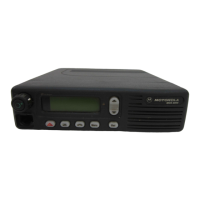160
Phone DTMF Timing Use the UP/DOWN arrow keys to select the set of DTMF timing
parameters for the current personality. Timing may be changed for
Initial Delay, Digit Duration and Interdigit Delay. The radio contains a
table with four sets of values of these parameters. The actual parameters
are entered on the RADIO WIDE PHONE CONFIGURATION screen (F4/F3/
F4).
The default is 1.
Initial Delay (ms) This is a view-only field. The value here can be adjusted by modifying
the value in the Phone DTMF Timing or Hot DTMF Timing fields as the
case may be.
Digit Duration (ms) This is a view-only field. The value here can be adjusted by modifying
the value in the Phone DTMF Timing or Hot DTMF Timing fields as the
case may be.
Interdigit Delay (ms) This is a view-only field. The value here can be adjusted by modifying
the value in the Phone DTMF Timing or Hot DTMF Timing fields as the
case may be.
Hot DTMF Timing Use the UP/DOWN arrow keys to select the set of DTMF timing
parameters for this personality. Timing may be changed for Initial
Delay, Digit Duration and Interdigit Delay. The radio contains a table
with four sets of values of these parameters. The actual parameters are
entered on the RADIO WIDE PHONE CONFIGURATION screen (F4/F3/
F4).
The default is 1.
Status Aliasing Use the UP/DOWN arrow keys to enable/disable Status Aliasing. This
option allows you to customize the Status number and assign an alias
name to each message (F6). The Status Alias feature must be enabled on
the TRUNKING PERSONALITY screen (F4/F4/F4), and the status
mnemonic (STS) must be assigned on the RADIO WIDE MENU
CONFIGURATION screen (F4/F3/F3/F4).
Message Aliasing Use the UP/DOWN arrow keys to enable/disable Message Aliasing for
this system. This option allows you to customize the Message number
and assign an alias name to each message (F7). The message feature must
be enabled on the TRUNKING PERSONALITY screen (F4/F4/F4), and the
message mnemonic (MSG) must be assigned on the RADIO WIDE MENU
CONFIGURATION screen (F4/F3/F3/F4).
Site Aliasing Use the UP/DOWN arrow keys to enable/disable Site Aliasing. This
option will permit you to customize the site number to assign an alias
name to each site. AMSS or SmartZone must be added on the TRUNKING
SYSTEM screen (F4/F4/F3) and the SITE mnemonic must be assigned on the
RADIO WIDE MENU CONFIGURATION screen (F4/F3/F3/F4) for this
feature to operate properly.
Zone Switch Debounce Timer
(sec)
This field will be displayed only if the OmiLink field is Enabled on the
Trunking System screeen (F4/F4/F3). This field defines the duration
that the radio will be forced to remain at a SmartZone System within
an OmniLink System before being allowed to switch to any other
SmartZone system within the OmniLink System. Keeping subscribers
from bouncing between Zones guarantees that the fixed end databases

